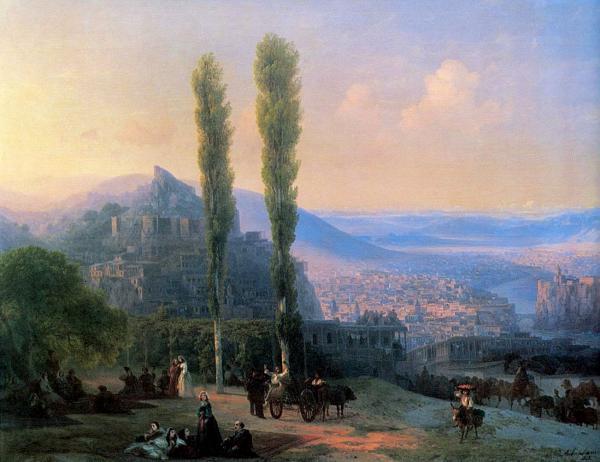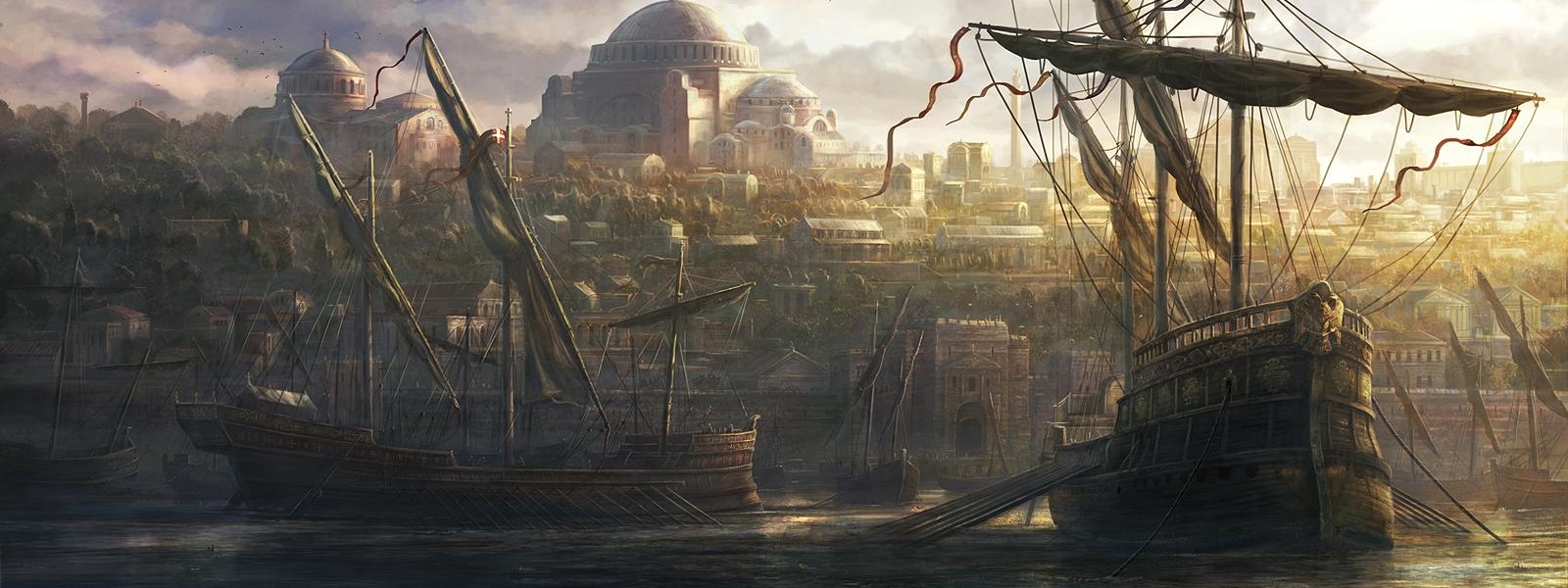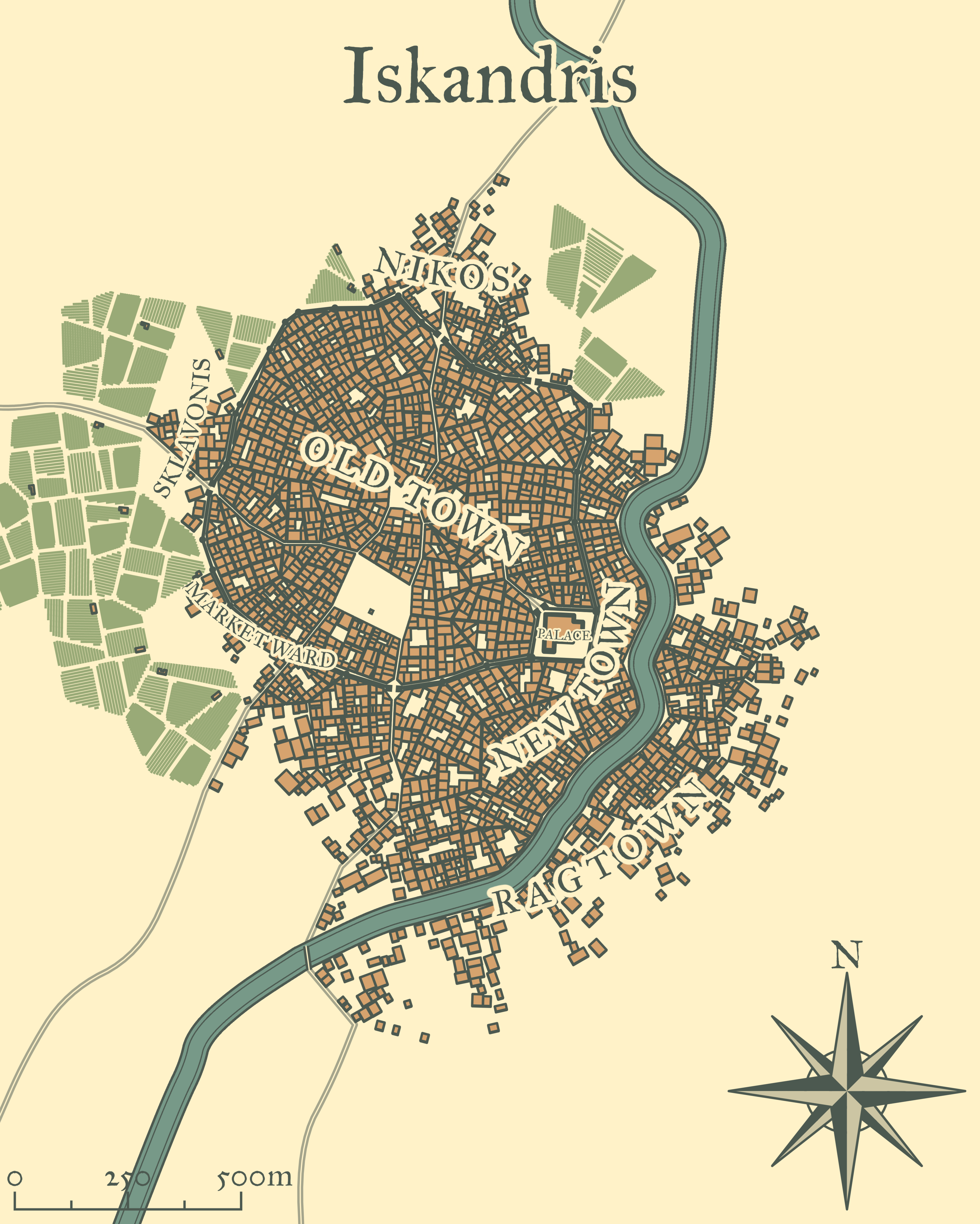Iskandris (/ ɪskandrɪs /)
Ιςκαντρις

View of Tiflis by Ivan Aivazovsky
Rising out of the hills of the Northern Tyros, the city of Iskandris is an impressive sight from affar. As you come closer however, you see more and more signs of trouble. Enslaved people of every race are marched through the states by heavily armed guards, and the screams and shouts of the slave pens of the Megalogra Sklavnonica can be heard almost anywhere in the city. By comparison wealth aristocrats can be seen everywhere riding in sedan chairs and looking down upon their lessers.Established on the frontiers of Aeillan territory, the city of Iskandris has carved out an important niche as the capital of the Aeillan slave markets and indeed a major locus of slavery in the whole of the Galisean continent. It serves as the capital, and the largest city of the Exarchate of the same name, and one of the most important cities on Aeilla's frontiers.
Wards of Iskandris
There are six major wards of the town and the citadel which is largely the palace, and not much else. The old town, the ward within the walls, with the outer wards, become increasingly impoverished with the poor freemen living on the hills across the river.The Citadel: Consisting of the inner walls, the palace, and a handful of semidetached outbuildings, the Citadel serves as the capital of the city, and is the heart of the city government.
Old Town: The Old Town, established within the walls, is the wealthiest, and most prosperous of the city's districts, home to the nobility, the merchants, and the skilled tradespeople of the city.
The Market Ward: A part of the Old Town, the market ward is centered around the city's agora, and is the heart of Iskandris' commercial activity.
Nikos: A smaller village that has, for the most part, been subsumed into the city of Iskandris, located just outside the wall. Largely housing for the aristocracy from outside the city, as the original inhabitants have been moved out.
Sklavonis: Sklavonis is a constructed walls village built explicitly to house the slaves owned by the ruling classes of the city close to the farm fields that are owned by the same aristocrats.
New Town: Established near the city's docks, the New Town is a place where a sizable chunk of craftspeople rub shoulders with the dockworkers, river pilots, and porters, and where such working-class people are allowed to do business.
Ragtown: The newest, and poorest district of the town, built near and on the slopes of Arsakan Mountain, largely consisting of the dispossessed from other wealthier districts, Ragtown is a den of crime, poverty, and misery.
Important Locations
Megalogora Sklavonica: The largest slave market in Galisea, the Megalogora Sklavonica is one of the most important sites in the whole of the Galisean slave trade. Here one can find any kind of sentient being sold to virtually any of the vile slaver class.The Agora: Next to the slave markets, and inextricably entwined with it is the Agora, the market hosts a wide variety of goods, brought from locations as exotic as the sentient traffic. There is rife corruption here, as some of the goods themselves were stolen from slaves when they are captured.
The Library of Iskandris: A major center of learning in Iskandris, the Library of Iskandris is one of the larger book repositories in the Aeillan region. Though not the equal of Cyrene, or even of Antiokos, it is one of the places where the learned classes can go to research topics from natural philosophies to the finer points of necromancy.
City Docks: A complex series of short jetties, warehouses, and secret passageways, the city docks are an integral part of the Iskandrian slave trade as sentient traffic is taken from the jetties into secreted warehouses, and eventually to the Sklavonica.
Arsakan Mountain: Home to the city's poor, much of ragtown is built on the slopes of this mountain, even as its interior is slowly mined out. A number of workhouses can be found here.
Temple of Io: Established near Arsakan Mountain, the Temple of Io was constructed by the city's poor as a focal point of their community. Promising a better future, and a victory over the wealthy elite, it has only grown in influence.
Illistis Mountain: Technically a location away from the city, Illistis Mountain is a picnicking location where the wealthy can get away from the city. It is also a relatively secret location where dark deeds can be conducted in relative privacy.
Demographics
The city of Iskandris is quite a large city with a semi-permanent population of 62,085. There is a large population (26,415) of slaves, and another large population (14,851) of indentured poor citizens, with only a small population of roughly 20,000 or so, freemen and full citizens. Tyroi humans are the most common denizens of the city, with them representing the bulk of the free and indentured population, with broad smatterings of Terruk, Cyrenic, Feloran, and other populations from all over the known world who are imported to provide slave labor.
Government
The city is governed directly by the Exarch and the Senate of Iskandris. The senate has an outsize influence on the running of daily affairs for the government. The senate handles much of the legislative duty, as well as the appointment of most, not armed civil servants, while the Exarch handles the appointment of the garrison commander, the reave, and most of the city watch. The civil service is relatively small for such a large city.
Defences
The city is defended primarily by its Old Town wall, which keeps most of the economically important parts of the city protected from casual attacks. The city maintains a small number of Akritae in the city, as well as the city watch. The true strength of the city lies in its mercenary population, as a number of wealthy peoples maintain fairly extensive retainers to go on slave raids, and to keep their current enslaved population under tight control.
Industry & Trade
The city of Iskandris is concerned first and foremost with the industry of looting and pillaging, with the economic heart of the city being its slave market, and the adjacent primarily looted agora. There is, however, a substantial industry consisting of goods manufactured by the city's skilled craftspeople, thanks in large part to iron ore mined out of the nearby mountains. Goods from all over Galisea can be found on Iskandrian markets, with the city being an important stop on the trans-Terruk-Mal trade route, as well as of the Galisean slave trade.
Infrastructure
The city of Iskandris is by far the best developed in the whole of the Exarchate, as the government wishes to impress potential foreign customers. The city can count on fountains, sewers, an aqueduct, and even some streetlights, roads near and within the city are paved, and the city, at least the Old Town and Market wards are kept beautiful. The docks are well developed, but kept out of the public eye, especially the offloading points for slaves.
Guilds and Factions
The city of Iskandris has significant class tensions that lay underneath the city's brutish and luxuriant slave society. At the top wrung are the aristocracy which holds most of the political power and influence. The second major faction is the trade guilds, which have slowly been forming and organizing the crafting class into a political force. Lastly, are the poor and dispossessed who have become increasingly malcontent with the state of things.
History
The city of Iskandris was established in the last days of the Yulan Tai empire as a small town near the river Iskend. At first refuge for those who had fled the growing tyranny of the Yulan-Tai Empire, it was eventually taken over as an outpost of the Empire. As the Yulan-Tai fell, however, the Imperial order never changed all that significantly, with a number of the functionaries of the state remaining the same, even as Iskandris became an independent city-state.
During the forging and Imperial eras, the city would grow in importance as its prime location allowed for trade in ore, and agricultural goods from nearby, as well as a convenient harbor for slavers from the southern Terruk steppes, Indahara, and the Hadar deserts. As a result, Iskandris flourished growing into the second-largest city on the Tyros, and at the helm of one of its most powerful Poleis. It was, however, eventually swallowed up by the Aeillan civilization, which largely kept it intact, profiting immensely off of the burgeoning slave trade. Iskandris was never attacked by the Felorans, and was indeed a major base of operations for attacks down the Tyros River. As a result, it grew further in importance and became a preeminent city when the Empire fell.
In the new post-Imperial order, Iskandris freed itself to become not only an important slave market but the locus of the whole Aeillan slave trade, gaining enormous wealth and prestige in the chaotic days shortly after the fall of the Empire. However, as abolitionism has begun to spread throughout Aeilla, even being backed by relatively powerful states, the star of Iskandris has begun to go into decline, and unrest is on the rise.
Geography
The city of Iskandris was founded near the banks of the River Iskend, and in the shadow of Arsakan Mountain, and has as a result relatively unique geography. Its western portions are relatively flat and densely settled with the wealthy living behind the walls. Poorer districts eventually reached, and crossed the river, eventually being built into Arsakan Mountain itself. This has resulted in one of the few cities where the poor overlook the wealthy.
Founding Date
EY 992
Type
Large city
Population
62,085
Inhabitant Demonym
Iskandrian, Iskandrian
Location under
Owner/Ruler
Ruling/Owning Rank
Owning Organization



